| 첨부 '3' |
|---|
| author | Dong Hoon Choi, Han Young Woo |
|---|---|
| journal | Adv. Funct. Mater. 2017, 27, 1701942 |
Two Regioisomeric π-Conjugated Small Molecules:
Synthesis, Photophysical, Packing and Optoelectronic Properties


Dae Hee Lee(박사과정) / Thanh Luan Nguyen(Post doc.)
Two regioisomeric D1-A-D-A-D1 type π-conjugated molecules (1,4-bis{5-[4-(5-fluoro-7-(5-hexylthiophen-2-yl)benzo[c][1,2,5]thiadiazole)]thiophen-2-yl}-2,5-bis(hexyldecyloxy)benzene (Prox-FBT) and 1,4-bis{5-[4-(6-fluoro-7-(5-hexylthiophen-2-yl)benzo[c][1,2,5]thiadiazole)]thiophen-2-yl}-2,5-bis(hexyldecyloxy)benzene (Dis-FBT)) are synthesized, by controlling the fluorine topology to be proximal or distal relative to the central core. The different F geometries are confirmed by the 1H–1H nuclear Overhauer effect spectroscopy (NOESY). Clearly different optical, electrochemical, and thermal transition behaviors are obtained, i.e., stronger absorption, deeper valance band (by ≈0.2 eV), and higher melting/recrystallization temperatures (by 7–20 °C) are observed for Dis-FBT. The different intermolecular packing and unit cell structures are also calculated for the two regioisomers, based on the powder X-ray diffraction and 2D grazing-incidence wide-angle X-ray diffraction measurements. A tighter π–π packing with a preferential monoclinic face-on orientation is extracted for Dis-FBT, compared to Prox-FBT with bimodal orientations. Different topological structures significantly affect the electrical and photovoltaic properties, where Prox-FBT shows higher parallel hole mobility (2.3 × 10−3 cm2 V−1 s−1), but Dis-FBT demonstrates higher power conversion efficiency (5.47%) with a larger open-circuit voltage of 0.95 V (vs 0.79 V for Prox-FBT). The findings suggest that small changes in the topological geometry can affect the electronic structure as well as self-assembly behaviors, which can possibly be utilized for fine-adjusting the electrical properties and further optimization of optoelectronic devices.
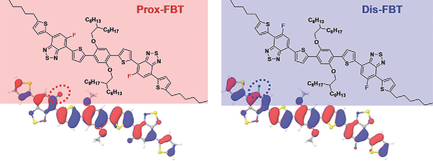
http://onlinelibrary.wiley.com/doi/10.1002/adfm.201701942/full
최동훈교수 홈페이지 : http://fpl.korea.ac.kr/
우한영교수 홈페이지 : http://www.ooml.korea.ac.kr/
-
Read More
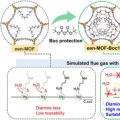
Boc Protection for Diamine-Appended MOF Adsorbents to Enhance CO2 Recyclability under Realistic Humid Conditions
Among the various metal–organic framework (MOF) adsorbents, diamine-functionalized Mg2(dobpdc) (dobpdc4– = 4,4-dioxidobiphenyl-3,3′-dicarboxylate) shows remarkable carbon dioxide removal performance. However, applying diam... -
Read More

Double-Walled Tubular Heusler-Type Platinum–Ruthenium Phosphide as All-pH Hydrogen Evolution Reaction Catalyst Outperforming Platinum and Ruthenium
Nanostructured ionic compounds have driven major technological advancements in displays, photovoltaics, and catalysis. Current research focuses on refining the chemical composition of such compounds. In this study, a strategy for creating s... -
Read More

Seebeck Effect in Molecular Wires Facilitating Long-Range Transport
The study of molecular wires facilitating long-range charge transport is of fundamental interest for the development of various technologies in (bio)organic and molecular electronics. Defining the nature of long-range charge transport is ch... -
Read More
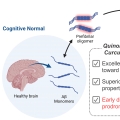
Early onset diagnosis in Alzheimer’s disease patients via amyloid-β oligomers-sensing probe in cerebrospinal fluid
Amyloid-β (Aβ) oligomers are implicated in the onset of Alzheimer’s disease (AD). Herein, quinoline-derived half-curcumin-dioxaborine (Q-OB) fluorescent probe was designed for detecting Aβ oligomers by finely tailoring ... -
Read More
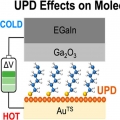
Thermopower in Underpotential Deposition-Based Molecular Junctions
Underpotential deposition (UPD) is an intriguing means for tailoring the interfacial electronic structure of an adsorbate at a substrate. Here we investigate the impact of UPD on thermoelectricity occurring in molecular tunnel junctions bas... -
Read More
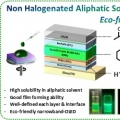
Eco-friendly solution-processed narrowband OLEDs using non-halogenated aliphatic solvent systems
In general, fabricating multilayer structures in solution-processed organic light-emitting diodes (OLEDs) presents challenges owing to the potential degradation of the initial film during subsequent processing steps. Furthermore, these devi... -
Read More
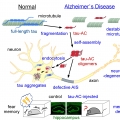
Self-Aggregating Tau Fragments Recapitulate Pathologic Phenotypes and Neurotoxicity of Alzheimer's Disease in Mice
In tauopathy conditions, such as Alzheimer's disease (AD), highly soluble and natively unfolded tau polymerizes into an insoluble filament; however, the mechanistic details of this process remain unclear. In the brains of AD patients, o... -
Read More

Ultranarrow Mid-infrared Quantum Plasmon Resonance of Self-doped Silver Selenide Nanocrystal
The infrared quantum plasmon resonance (IR QPR) of nanocrystals (NCs) exhibits the combined properties of classical and quantum mechanics, potentially enabling unprecedented optics. However, research on the development of localized surface ... -
Read More
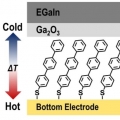
Molecular Thermoelectricity in EGaIn-Based Molecular Junctions
Understanding the thermoelectric effects that convert energy between heat and electricity on a molecular scale is of great interest to the nanoscience community. As electronic devices continue to be miniaturized to nanometer scales, thermor... -
Read More
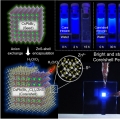
Perovskite Nanocrystals Protected by Hermetically Sealing for Highly Bright and Stable Deep-Blue Light-Emitting Diodes
Metal–halide perovskite nanocrystals (NCs) have emerged as suitablelight-emitting materials for light-emitting diodes (LEDs) and other practicalapplications. However, LEDs with perovskite NCs undergoenvironment-induced and ion-migratio... -
Read More
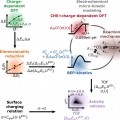
The importance of a charge transfer descriptor for screening potential CO2 reduction electrocatalysts
It has been over twenty years since the linear scaling of reaction intermediate adsorption energies started to coin the fields of heterogeneous and electrocatalysis as a blessing and a curse at the same time. It has established the possibili... -
Read More
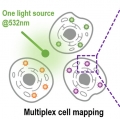
Resonant Raman-Active Polymer Dot Barcodes for Multiplex Cell Mapping
Resonance Raman spectroscopy is an efficient tool for multiplex imaging because of the narrow bandwidth of the electronically enhanced vibrational signals. However, Raman signals are often overwhelmed by concurrent fluorescence. In this stud... -
Read More
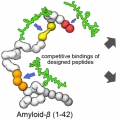
Decoding the Roles of Amyloid-β (1-42)'s Key Oligomerization Domains toward Designing Epitope-Specific Aggregation Inhibitors
Fibrillar amyloid aggregates are the pathological hallmarks of multiple neurodegenerative diseases. The amyloid-β (1-42) protein, in particular, is a major component of senile plaques in the brains of patients with Alzheimer’s di... -
Read More

Flattening bent Janus nanodiscs expands lattice parameters
Nanoscale lattice parameter engineering is a potentially powerful tool for tailoring the electronic properties of nanomaterials. The nascent strain in juxtaposed hetero-interfaces of nanocrystals was recently shown to substantially affect t... -
Read More
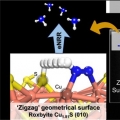
Directing the surface atomic geometry on copper sulfide for enhanced electrochemical nitrogen reduction
Understanding catalytic-conversion determinants will blueprint an efficient electrocatalyst design for electrochemical nitrogen reduction. In metal chalcogenide-based catalysts, metal-site nitrogen adsorption initiates nitrogen fixation, an... -
Read More
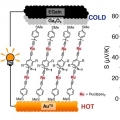
High Seebeck Coefficient Achieved by Multinuclear Organometallic Molecular Junctions
This paper describes thermoelectric property of molecular junctions incorporating multinuclear ruthenium alkynyl complexes that comprise Ru(dppe)2 (dppe = 1,2-bis(diphenylphosphino)ethane) fragments and diethylnyl aromatic bridging ligands ... -
Read More
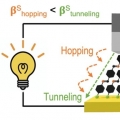
Thermopower in Transition from Tunneling to Hopping
The Seebeck effect of molecular junction in a hopping regime or tunneling-to-hopping transition remains uncertain. This paper describes the Seebeck effect in molecular epitaxy films (OPIn where n = 1 – 9) based on imine condensation b... -
Read More
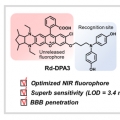
An Activity-Based Fluorescent Probe for Imaging Fluctuations of Peroxynitrite (ONOO-) in the Alzheimer's Disease Brain
Peroxynitrite (ONOO-) plays a critical role in Alzheimer's disease (AD), and the association between ONOO- and AD is inexplicit. To reveal the ONOO- influxes in AD brains, an activatable activity-based fluorescence probe Rd-DPA3 was rat... -
Read More

Deep learning for development of organic optoelectronic devices: Efficient prescreening of hosts and emitters in deep-blue fluorescent OLEDs
The highest occupied molecular orbital (HOMO) and lowest unoccupied molecular orbital (LUMO) energies, which are key factors in optoelectronic devices, must be accurately estimated for newly designed materials. Here, we developed a deep lea... -
Read More
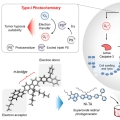
Photocatalytic Superoxide Radical Generator that Induces Pyroptosis in Cancer Cells
In this study, we show that a photocatalytic superoxide radical (O2−•) generator, NI-TA, triggers pyroptosis in cancer cells. NI-TA was designed to take advantage of an intramolecular triplet-ground state splitting energy modulat...

